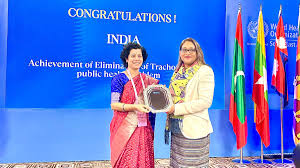Elimination of Trachoma as a Public Health Problem
- 21 May 2025
In News:
At the 78th World Health Assembly in Geneva (May 2025), the World Health Organization (WHO) officially recognized Papua New Guinea (PNG) and India for eliminating trachoma as a public health problem. This marks a significant milestone in global efforts to combat neglected tropical diseases (NTDs).
What is Trachoma?
- Cause: Bacterial infection by Chlamydia trachomatis
- Transmission:
- Direct contact with infected eye/nasal discharges (via hands, clothes, bedding)
- Flies that have come into contact with infected discharges
- Reservoir: Predominantly spread among children in endemic regions
- Symptoms:
- Early: Red eyes, discharge, pain, light sensitivity
- Advanced:Trachomatous trichiasis – inward-turning eyelashes causing corneal damage and irreversible blindness
Risk Factors & Epidemiology:
- Major Risk Factors:
- Poor hygiene and sanitation
- Overcrowded housing conditions
- Limited access to clean water
- Gender Disparity: Women are 4 times more affected due to caregiving-related exposure
- Global Burden (as of 2023):
- Endemic in 38 countries
- Affects 1.9 million people with visual impairment/blindness
- Over 130,000 surgeries and 32.9 million antibiotic treatments administered globally in 2023
Trachoma Elimination in Papua New Guinea (2025):
- Validation: Based on detailed epidemiological data and surveillance (2015–2020)
- Key Findings:
- Presence of mild active trachoma in children but negligible trichiasis
- No need for mass drug administration or surgical interventions
- Intervention Strategy:Emphasis on surveillance, community-level assessments, andtargeted response
- Support & Partnerships:WHO, Fred Hollows Foundation, Australian DFAT, PNG Eye Care, London School of Hygiene & Tropical Medicine, among others
- Significance: First NTD eliminated in PNG; part of WHO’s NTD Road Map 2021–2030
Trachoma Elimination in India (Certified in May 2025):
- Timeline:
- Declared trachoma-free in October 2023
- WHO Certification in May 2025
- India’s Strategy:
- Implemented active surveillance through NPCBVI since 2019
- National Trichiasis Survey (2021–2024) covered 200 districts
- Regional Achievement:India is the third country in WHO South-East Asia Region, after Nepal and Myanmar, to eliminate trachoma
Global Status of Trachoma Elimination:
- Countries Validated for Elimination: 22 countries including India, Nepal, China, Pakistan, Iran, Morocco, Vietnam, Mauritania, and PNG
- Part of Broader NTD Goals: WHO supports member countries to eliminate at least one NTD under the 2021–2030 roadmap
Trachoma

- 09 Oct 2024
In News:
The World Health Organization (WHO) has now recognised that India has successfully eliminated trachoma, a bacterial infection that affects the eyes, as a public health problem.
WHO Declaration:
- India has eliminated Trachoma as a public health problem (2024).
- Third country in the South-East Asia Region to achieve this milestone.
Trachoma Overview:
- Bacterial infection caused by Chlamydia Trachomatis.
- Contagious; spreads through contact with infected secretions.
- Can lead to irreversible blindness if untreated.
- Considered a neglected tropical disease.
Global Impact:
- WHO estimates 150 million affected worldwide; 6 million at risk of blindness.
- Most prevalent in underprivileged communities with poor living conditions.
Historical Context in India:
- Leading cause of blindness in the 1950s-60s.
- National Trachoma Control Program launched in 1963.
- Control efforts integrated into the National Program for Control of Blindness (NPCB).
Statistics:
- Blindness due to Trachoma was 5% in 1971; now reduced to less than 1%.
- Implementation of the WHO SAFE strategy (Surgery, Antibiotics, Facial hygiene, Environmental cleanliness).
Milestones:
- India declared free from infective Trachoma in 2017.
- Continued surveillance for cases from 2019 to 2024.
National Trachomatous Trichiasis (TT) Survey:
- Conducted in 200 endemic districts (2021-2024) under NPCBVI.
- Mandated by WHO to confirm elimination status.
